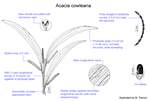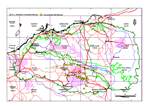Click on images
to enlarge



Brown new shoots. Photographer: B.R. Maslin

Photographer: B.R. Maslin
, BRM 5279, ORIGINAL SCAN, ADJUSTED RICHARD WOODMAN_sml.jpg)
Photographer: B.R. Maslin

Photographer: B.R. Maslin

Photographer: B.R. Maslin

Photographer: B.R. Maslin

Seeds with aril excised by ants. Photographer: B.R. Maslin
, LSWE 7050, lab photo by Fiona McCallum ADJUSTED_sml.jpg)
Seed from one herbarium voucher. Scale in mm. Photographer: F. McCallum.
Botanical name
Acacia cowleana Tate, Rep. Horn Sci. Exped. pt 3: 157, 187 (1896)
Aboriginal name
Wathamalu or Waddamullu (Kurrama)
Description
Openly branched and sometimes rather spindly shrubs 1.5-3 (-4) m tall, may be a tree to 8 m high outside the Pilbara. Bark grey, thin, fibrous and longitudinally fissured towards base of main stems or mature plants, smooth on upper branches. Branchlets angled at extremities but soon terete, minutely sericeous but hairs becoming sparse with age, rarely glabrous (outside the Pilbara). New shoots at initiation encrusted with dark or rusty-brown resin that obscures the underlying appressed indumentum, soon aging silvery or golden-sericeous, rarely glabrous (outside the Pilbara). Phyllodes shallowly to moderately and uniformly falcately recurved over their entire length or sometimes ±straight and dimidiate to sub-falcate, (7-) 12-20 (-22) cm long, 14-36 mm wide, coriaceous, wide-spreading, minutely and moderately to densely sericeous (hairs minute and closely appressed, difficult to see with the unaided eye), rarely glabrous, silvery green or grey-green to sub-glaucous; parallel longitudinal nerves numerous, ±widely spaced (2 or 3 per mm), with 3 more evident than the rest and the lowermost 2 running together at base of the phyllode (but remaining separate from the lower margin), with a relatively few of the minor nerves forming longitudinally orientated anastomoses; apex rounded-obtuse to sub-acute and terminated by a knob-like or ±oblong hard point 0.5-1.5 mm long. Gland absent from apex of phyllodes. Inflorescences (1-) 2 within axil of phyllodes, simple or vestigial binate racemes with axes to 2 mm long; peduncles (1-) 3-10 mm long, sparsely to densely sericeous, rarely glabrous; spikes 3-5 cm long, bright golden, flowers sub- densely arranged within the spikes. Flowers 5-merous; calyx very shallowly dissected into broadly triangular lobes; petals glabrous. Pods linear, slightly to moderately raised over the seeds and scarcely constricted between them, 4-12 cm long, 3.5-5 mm wide, thinly coriaceous to chartaceous, straight to shallowly curved, glabrous or very sparsely and minutely hairy (hairs difficult to see with the unaided eye), dark brown. Seeds longitudinal in the pods, ±obloid, (3-) 3.5-4 (-5) mm long, glossy, very dark brown to black; aril bright yellow.
Characteristic features
Branchlets minutely sericeous. New shoots encrusted with dark brown resin when first initiated. Phyllodes large (mostly 12-20 cm x 14-36 mm), uniformly shallowly to moderately falcately recurved, wide-spreading, silvery green or grey-green to sub-glaucous, with many longitudinal nerves which are ±widely spaced (the few intervening minor nerves ±sparsely longitudinally anastomosing), 2 of the 3 more prominent nerves running together at base of the phyllode, apical point knob-like or ±oblong and 0.5-1.5 mm long. Gland absent from apex of phyllodes. Spikes long (3-5 cm), bright golden, the flowers sub-densely arranged; petals glabrous. Pods linear, straight to shallowly curved, 3.5-5 mm wide, thin textured. Seeds very dark brown to black with a bright yellow aril.
Distribution and ecology
Acacia cowleana has a wide, discontinuous distribution in the northern arid zone of Australia between latitudes 20 and 25 degrees S. Its main area of occurrence extends from the far eastern Kimberley region in Western Australia through central-southern Northern Territory to central Queensland and south into central-northern New South Wales. In the Pilbara A. cowleana occurs mainly in the central Hamersley Range area but there are isolated occurrences to the north, near Mount Florance and Hillside stations. It often forms localized populations and is not a particularly common element within the landscape. It grows in a range of habitats but is mainly found in reddish, slightly acidic (pH 5-6) sandy loam along seasonally dry watercourses and diffuse drainage lines (see McDonald and Maslin 1997 for further details). It commonly occurs in disturbed sites, especially those receiving supplementary water from run-off, such as road verges.
Flowering and fruiting period
Flowers from late May to August and pods with mature seeds occur from September to November. Acacia cowleana produces relatively heavy seed crops.
Variation
Within the Pilbara this is an invariate species. However, as discussed by McDonald and Maslin (1997) glabrous and other variants occur in Northern Territory and Queensland.
Affinities
Acacia cowleana is most closely allied to A. elachantha and on account of its large phyllodes and inflorescence spikes is at least superficially similar to A. colei var. colei and A. holosericea (see these taxa for distinguishing features).
Notes
Acacia cowleana is a fast growing, short-lived species often used in seed-mixes for mine site rehabilitation. It has the ability to regenerate from basal coppice, however, it more commonly regenerates from seed (especially following disturbance).
This is a very showy species on account of its usually silvery foliage and large, bright golden spikes. As such it could have potential as an ornamental for amenity planting in dry tropical areas.
When in fruiting A. cowleana is very attractive to corellas and galahs that descend on the plants to eat the seeds.
The information given under A. cowleana in Doran and Turnbull (1997) and Latz (1995) is mainly attributable to A. elachantha.
Conservation status
Not considered rare or endangered.
Origin of name
The type specimen of this species was collected on the Horn Expedition to central Australia at the end of the nineteenth century (see Tate 1896). The botanical name probably commemorates E.C. Cowle, who helped with the zoological collections and was apparently regarded as an honorary member of the expedition (Hall 1984).
References
Doran, J.C. and Turnbull, J.W. (1997). Australian trees and shrubs: species for land rehabilitation and farm planting in the tropics. ACIAR Monograph No. 24. pp. 384. (Australian Centre for International Agricultural Research: Canberra.)
Hall, N. (1984). Botanists of Australian Acacias. pp. 64. (CSIRO: Melbourne.)
Latz, P.K. (1995). Bushfires and Bushtucker: Aboriginal plant use central Australia. pp. 400. (IAD Press: Alice Springs.)
McDonald, M.W. and Maslin, B.R. (1997). A reappraisal of Acacia cowleana and allied taxa, including the description of a new species, A. elachantha , from the tropical dry-zone of Australia. Australian Systematic Botany 10: 303-320.
Tate, R. (1896). Acacia. In: B. Spencer (ed.) Report on the work of the Horn Scientific Expedition to Central Australia (Duban and Co.: London, and Melville, Mullen & Slade: Melbourne.)
